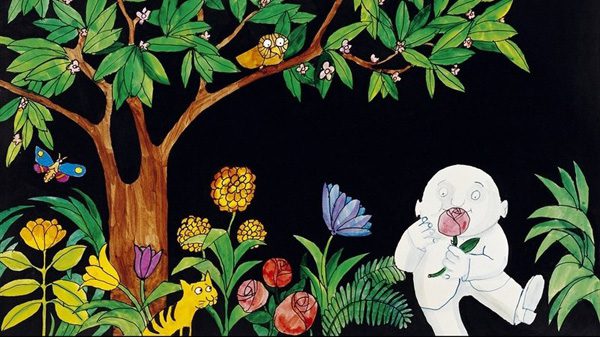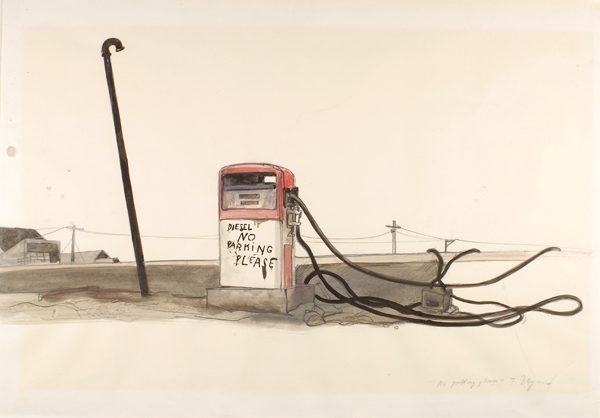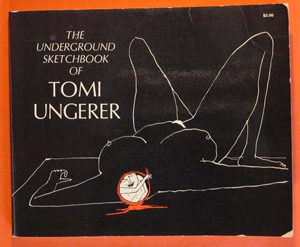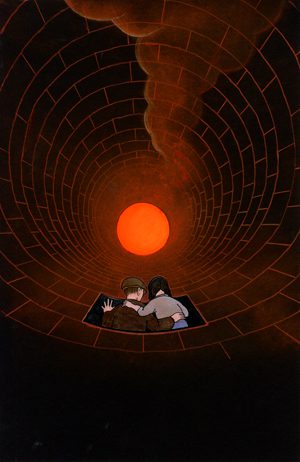Three robbers “steal” a young orphan who opens their hearts, eventually leading them to share their wealth with other lost, unhappy, and abandoned children. A bat who is disenchanted with his appearance attempts to paint himself in vivid colors and fly around in the daytime only to realize he belongs to the night. A lonely retired tax collector finds unexpected companionship with a curious beast who has stolen fruit from his beloved pear tree. Reading Tomi Ungerer’s stories sustained me as a child, made me feel—as all art should—a little less alone. It was not until many years later that I rediscovered these treasures via an animated version of The Beast of Monsieur Racine, which appeared on a DVD collection of children’s classics that I bought for my sons.
The man behind these emotionally complex stories of who we are and where we fit in was born in Strasbourg, France in 1931, and grew up under Nazi occupation in Alsace, on the French-German border. Deeply influenced by the work of Saul Steinberg, Tomi Ungerer came to New York in 1956 with $60 in his pocket and a trunk full of drawings. In the golden age of magazines, he was an overnight success, landing illustration work for such publications as the New York Times, Esquire, Life, Harper’s Bazaar, and the Village Voice. In 1957, the visionary and subversive Harper & Row editor Ursula Nordstrom published Ungerer’s first children’s book, The Mellops Go Flying, to critical acclaim. The Mellops became a popular series,  and many other children’s titles followed, among them: Crictor (1958), Adelaide (1959), Emil (1960), Rufus (1961), The Three Robbers (1961), and Moon Man (1967).
and many other children’s titles followed, among them: Crictor (1958), Adelaide (1959), Emil (1960), Rufus (1961), The Three Robbers (1961), and Moon Man (1967).
During this period Ungerer also wrote satirical books for adults, as well as publishing political posters protesting segregation and the Vietnam War. The self-publication of Fornicon (1969), a book of erotic drawings depicting people engaged in sexual activities with pleasure machines, upended his career in America. Unable to accept that a children’s book author could also produce provocative adult-themed work, Ungerer was invited to the annual convention of the American Library Association, and then attacked by the librarians during a Q & A session. He was subsequently blacklisted by libraries across the country. Disillusioned with the US, Ungerer and his wife decamped for Nova Scotia, eventually settling permanently in rural Ireland, where they’ve lived since the mid-seventies.
Ungerer has remained creatively active, publishing over one hundred and forty books in more than forty languages. But he is only now becoming known again in the US after Phaidon acquired the rights to almost all of his work and started republishing his children’s books in English in 2008. In 2011 the Eric Carle Museum of Picture Book Art presented a comprehensive show of Ungerer’s children’s book drawings, and in 2012 the documentary Far Out Isn’t Far Enough: The Tomi Ungerer Story drew even more interest, as well as a nomination for a Producers Guild of America Award. The Drawing Center in New York has now opened the first comprehensive US retrospective of Ungerer’s work, “Tomi Ungerer: All in One,” and I had the chance to interview Ungerer hours before the exhibition’s public reception. I found him gracious, candid, and—especially given his many accomplishments—remarkably humble.
***
The Rumpus: First of all, welcome back to New York, and thanks so much for taking the time to talk with me! The Drawing Center’s “All in One” is both a career retrospective and a reintroduction of your work to American audiences. Can you tell me how this exhibition came about?
Ungerer: About five or so years ago attention to my work in America was renewed when Michael Kimmelman wrote an article about me in the New York Times after visiting with me in Strasbourg. It was Phaidon who decided to publish me again in English, and in terms of children’s books they’ve done a splendid job of catching up. They’ve also published one adult book of mine, one of my autobiographies  about my time in Canada. That changed everything.
about my time in Canada. That changed everything.
As for this specific exhibit, my daughter decided to become my representative. She said, “Now that you’re published again in English, let’s try to come back with New York.” We met with the Drawing Center, and it developed from there. Claire Gilman, the Center’s curator, came to Ireland and Strasbourg where a lot of my work is displayed in the museum. She was able to put many styles into The Drawing Center exhibit to give people a clean and basic idea of my work—at least with respect to my drawing and animations.
Rumpus: Let’s go back and retrace your history in New York. When you first came here in 1956, you famously got your start by cold calling art directors, carrying around your portfolio in a paper bag. Tell me about the New York of the ’50s, what life was like for you as you tried to establish your career here.
Ungerer: In those days illustration was all over the place, in all of the magazines. It was just wonderful! I was struck by the kindness and welcome and how easily people would just give appointments. You could just call! Everyone took care of me, and I will always be grateful. I still love New York as much as I ever did. It’s an electric town. One just feels it!
Rumpus: How did you first connect with Ursula Nordstrom at Harper & Row?
Ungerer: Well, I must tell you that the children’s book level was pretty bad. The biggest outfit at the time was Golden Books. I went there and saw the head editor-in-chief. I didn’t even know his name—I just went there. And he received me, and said, “Yes, this is great work but you’re in America, and your style just doesn’t fit here. This is not the kind of thing I can use or publish. There is only one woman who would do this kind of work, who would publish your kind of books, and that’s Ursula Nordstrom.” And then he picked up the telephone and called Ursula Nordstrom and said, “Hey, I’ve got a young Frenchman here whose work you might be really interested in” and he arranged for an appointment for me to see her.
I can use or publish. There is only one woman who would do this kind of work, who would publish your kind of books, and that’s Ursula Nordstrom.” And then he picked up the telephone and called Ursula Nordstrom and said, “Hey, I’ve got a young Frenchman here whose work you might be really interested in” and he arranged for an appointment for me to see her.
Rumpus: Harper published your first children’s book, The Mellops Go Flying (1957), the year after you arrived in the US. How many children’s books did you publish between the Mellops series and Allumette in 1974?
Ungerer: I would say maybe twenty to twenty-five books. On average I did about three books a year.
Rumpus: You were quite prolific! While you were doing these children’s books, you were also doing illustrations, advertising campaigns, satirical books for adults, and then you also began creating political posters denouncing segregation, the Vietnam War…
Ungerer: Yes. [Laughs]
 Rumpus: The political posters seemed not to raise an eyebrow in the children’s literature world, but it was a different story with your erotic drawings, which essentially resulted in you being blacklisted. At what point did you decide to leave the US?
Rumpus: The political posters seemed not to raise an eyebrow in the children’s literature world, but it was a different story with your erotic drawings, which essentially resulted in you being blacklisted. At what point did you decide to leave the US?
Ungerer: Well, actually my trouble started earlier than the erotica. In 1960 I applied for a visa to visit “Red China.” I would have been for Newsweek one of the first reporters to go, so I went from New York to Paris, and then came a Telex saying if I went to China I would not be allowed back into the United States. It was a witch-hunt in those days, and wanting to go to China made me a Communist. So I gave up on my trip, but when I arrived in New York, I was arrested and kidnapped, just like in the movies. They grabbed me. There were three men in the hall, and one said, “Drop your suitcases quietly!” The guy behind grabbed my suitcases, and then they whisked me off in a car. Then they grilled me, they even opened the soles of my shoes, and after that my telephone was tapped, and my mail was opened. The message was: “Get out of here.” And then Kennedy was elected, and I wasn’t tapped anymore, but it was the beginning of my problems. Even before the erotica, I’d been pegged as a Communist, and that’s when it really started. Then came the erotica.
Rumpus: When you left the US, did you plan for your move to be permanent?
 Ungerer: I left in ’71, the year after I met my wife, Yvonne. I just felt that the atmosphere had changed—and I felt it was time to go.
Ungerer: I left in ’71, the year after I met my wife, Yvonne. I just felt that the atmosphere had changed—and I felt it was time to go.
Rumpus: So you moved first to Canada and then to Ireland, where you’ve lived since ’76. Why did you choose Ireland?
Ungerer: Yvonne and I wanted to leave Canada. It was lawless where we lived—even the police station was closed. We decided to have a family, and at the time everyone was talking about Ireland. Yvonne was pregnant when we went to Ireland, and we fell in love. It’s the quality of the people we found there, the right kind of spirited-minded people. That was that. We went back with six suitcases.
Rumpus: You’ve called your most recent children’s book, 2013’s Fog Island, your tribute to Ireland. It tells the story of a brother and sister who live on the Irish coast but are caught in a storm and transported by boat to Fog Island, a mysterious and ominous place from which no one is said to return alive. But the children don’t give in to their fear, and ultimately, they’re rewarded for the openness and curiosity.
Ungerer: Yes, but I believe children should always be scared. In my studio I have a skeleton, and the other day I had a visitor: a woman who came with her little six year old daughter, and she said, “I came because I visited you when I was a child. My mother brought me here, and I was scared of the skeleton, and you told me the skeleton was your momma, and you asked me to shake her hand, and I was terrified to shake the hand of your dead mother.” Then I explained to her that it was a joke and through jokes you overcome fear.
Rumpus: Well, it’s complicated, right, because your children’s books take the readers from despair to humor, from fear to courage? It’s the working through that brings the catharsis.
 Ungerer: Yeah. My mother was fearless, you know, and I was brought up that way. Can you imagine a woman: “We’re called in to the Gestapo! We may be arrested immediately and sent to a Concentration camp,” and my mother, taking me with her, is winking at me and saying, “Don’t worry; they’re all idiots!” [Laughs] What an attitude!
Ungerer: Yeah. My mother was fearless, you know, and I was brought up that way. Can you imagine a woman: “We’re called in to the Gestapo! We may be arrested immediately and sent to a Concentration camp,” and my mother, taking me with her, is winking at me and saying, “Don’t worry; they’re all idiots!” [Laughs] What an attitude!
Rumpus: As I look back at the characters you’ve created in your children’s books, I see that the heroes are unlikely—they may be outcasts, and they’ve often had to overcome disadvantages of one kind or another to find companionship or realize that they prefer solitude. As you look back at these characters, are there particular ones you identify with the most?
Ungerer: I identity a little bit with all of them. I’m always on the side of the underdog. I identify with my snake, my octopus, all of my rejected animals. You will find me in the heroes of all my children’s books.
Rumpus: Your work is gaining more and more renewed attention in the US. Does this exhibition, here in New York, feel like coming full circle for you?
Ungerer: Yes, it’s very comforting. I just met yesterday with the son of Bill Cole, who was a great cartoon specialist and my editor for The Underground Sketchbook. And in those days I was sharing a house with Philip Roth, and he wrote the preface for The Underground Sketchbook, and the publisher said they wouldn’t publish it because Philip Roth was not famous enough! [Laughs] This is irony, you know! Had he known!
Rumpus: There have been a long series of ironic reversals. I understand that the American Library Association has even screened the 2012 documentary that was made about you at one of their recent conventions.
Ungerer: Yes. I’ve heard that. [Laughs]
 Rumpus: You once thought up a brilliant slogan, originally for the New York Lottery, then later adopted by the Village Voice: “Expect the Unexpected.” What can we expect next from Tomi Ungerer?
Rumpus: You once thought up a brilliant slogan, originally for the New York Lottery, then later adopted by the Village Voice: “Expect the Unexpected.” What can we expect next from Tomi Ungerer?
Ungerer: [Laughs] It’s impossible for Phaidon to catch up on everything! But I wouldn’t mind if some of my other autobiographical books were to come out in English, and maybe some of my aphorisms and plays on words. I’m sure everything will find its time. In terms of new work, for me it’s all about my writing now and my sculpture. There’s a big museum of modern art in Zurich that will show my sculpture and other artwork this fall. I would really love to have a sizeable show of my new work in America, too.
***
“Tomi Ungerer: All in One” will run through March 22nd. For more information about the retrospective, click here. For more on Ungerer’s work, click here.
And just announced! Phaidon’s next Ungerer reissue, Snail, Where Are You?, is scheduled for April 15th.
***
Feature image courtesy of Tomi Ungerer. Images of Eat, No Parking Please, and Untitled from Fog Island courtesy of The Drawing Room. The “cat” daycare center is a 2011 collaboration between Ungerer and the architectural firm Ayla-Suzan Yöndel for Europe without Borders. Image of Snail, Where Are You? is courtesy of Phaidon.





3 responses
What a wonderful interview! Thank you.
Thanks for the far-reaching interview!
It is very moving to see an artist fully released throughout a lifetime in so many fields of creativity.
I knew Tomi in the late 1960s and feel that the fierce mordant eroticism wasn’t an outlier but part of the direct way his work addresses whatever is frightening – for the child, the adult, the society. I hope to see the exhibit Saturday afternoon and hope more of his work comes to NY.
Way back, maybe the 80’s, my children’s literature class and I called Mr. Ungerer on the telephone to answer questions of the students. Unbeknownst to me he was in Paris, held a high office in the arts, but nonetheless talked with us and answered questions. He remains my all time favorite among picture book creators. apn
Click here to subscribe today and leave your comment.